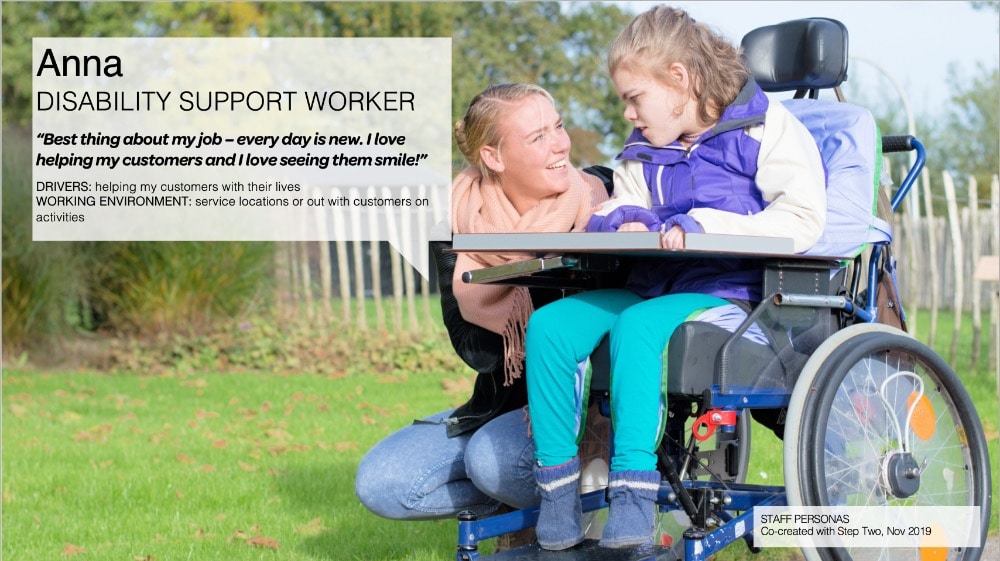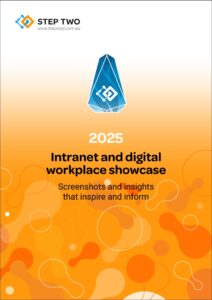
Workers in warehouse from Shutterstock.
Filed under: Articles, Digital employee experience, Intranets, Usability
Before embarking on any enterprise project, it is important to understand the needs of your workforce. It is then possible to develop a suitable strategy, select the features and functionality that will make the solution a success, and deliver a design that works for staff.
There are many ways to identify the needs of employee, such as interviewing users, holding discussions with business stakeholders, and conducting surveys. All of these may benefit from the use of personas that communicate the insights gained from research in a clear and engaging way.
This article explains what employee personas are, the benefits of using them, and practical steps towards creating them. The article Narrative is at the heart of digital employee experience then puts personas in the context of wider, more strategic initiatives.
(Editors note: this an updated version of the previous article “An introduction to personas and how to create them”, written by Tina Calabria, an alumni of Step Two.)
What are personas?
Personas are archetypal users that represent the needs of larger groups of users, in terms of their goals and personal characteristics. They act as ‘stand-ins’ for real users and help guide decisions about strategy, functionality and design.
Personas identify the user motivations, expectations and goals responsible for driving online behaviour, and bring users to life by giving them names, personalities and even a photo.
Although personas are fictitious, they are based on knowledge of real users. Some form of user research is conducted before they are written to ensure they represent end users rather than the opinion of the person writing the personas.
In the context of enterprise projects, personas are hugely valuable in articulating the needs of employees.
What do employee personas look like?
Over the years, a wide range of employee personas have been created by winners of Intranet and Digital Workplace Awards. These are a few samples, to show the diversity of content and design.

One of two pages for “Owen the Environment Officer” at the Environment Agency UK. Image from the Intranet and Digital Workplace Awards.

The second of two pages for “Owen the Environment Officer” at the Environment Agency UK. Image from the Intranet and Digital Workplace Awards.

Mayo Clinic chose to dive deeply into the needs of many different roles, with four pages of information captured for each.
In our consulting work, Step Two has also created many personas for employee-facing projects. We deliberately seek to find a balance between conveying key details and helping the reader to engage with the employees and their needs. This is one example:

Image copyright Step Two, all rights reserved.

Image copyright Step Two, all rights reserved.
Benefits of creating personas
Personas enable teams to stand in the shoes of employees. They focus the design effort on supporting user goals, rather than being driven by the ideas of team members or senior executives.
Introducing personas into your project will bring a number of benefits:
- employee goals and needs become a common point of focus for the team
- strategy and roadmap decisions can be clearly guided by employee needs
- the team can concentrate on designing for a manageable set of personas knowing that they represent the needs of many employees
- they are relatively quick to develop and replace the need to canvass the whole workforce or spend months gathering user requirements
- they help avoid the trap of building what users ask for rather than what they will actually use
- design efforts can be prioritised based on the personas
- disagreements over design decisions can be sorted out by referring back to the personas
When to create employee personas?
In our client work, we are often asked when personas should be created, and whether they would be valuable as part of the current project.
Our guidance is as follows:
- Employee personas are most useful where there are groups of workers that have distinct needs and activities (eg researchers, sales people or care workers).
- Personas are also applicable when employees work in unusual or challenging environments (eg nurses in a hospital, or operators in a call centre).
- Meaningful personas don’t generally follow the organisation structure, but instead focus on job roles and responsibilities.
- Beware of very generic personas (such as ‘new starters’ or ‘managers’), as these can gloss over key differences in employee needs.
- Make sure sufficient time and effort is put into creating employee personas, so they are accurate and valuable.
How to create personas
Employee personas are best created early in a project, and they must always be based on a firm understanding of real workforce needs.
The fundamental process for creating effective employee personas is as follows:
- Conduct user research
- Analyse research and identify potential personas
- Co-create personas with key stakeholders
- Validate personas with employees
- Widely engage the business to ensure persona adoption
The following sections explore each of these steps. (Note that there are many variations to the methodologies for creating personas, and we highly recommend the book The User is Always Right by Steve Mulder and Ziv Yaar for a deeper dive.)
1. Conduct user research
There are a wide range of research methods that can be used, as outlined in Conducting needs analysis. These include:
- One-on-one interviews with employees to gain a holistic view of activities and needs.
- Workplace observation to understand the work environment, and how it impacts workforce activities.
- Contextual inquiry, a variation of interviews that dives into how tasks are completed, and which systems are used.
- Surveys to gather broad (but shallow) information about the wider workforce.
- Focus groups to gain insights into feelings and motivations, and how groups work together.
The creation of employee personas should also draw on every other source of information that exists within the business, including:
- Internal communication surveys to understand needs and gaps regarding internal news.
- Staff culture surveys that provide a broad health check across many workforce aspects.
- IT planning documents that give details on the platforms, tools and devices that are in use.
- HR discussions that can yield actual demographic details for the workforce.
- Business stakeholders who can offer a strategic view of the current state.
- Corporate services staff who have frequent interactions with employees, such as HR or comms teams.
As always, practice good interview techniques and make sure you conduct research with the whole workforce. Note also that research can be conducted remotely if needed, and with due consideration, this can yield as useful results as in-person research.
2. Analyse research and identify potential personas
Review all the research data and look for patterns in attitudes and behaviours. For example, you may find common issues relating to remote access for field staff, and these may heavily impact on their ability to deliver good client outcomes.
You may also identify employees who need to access information under strict time pressures, those who travel frequently as opposed to infrequently, or those primarily involved in ‘knowledge work’.
Whilst listing these patterns, you will begin to see clusters of attitudes and behaviours that make up different personas. Note that these don’t necessarily match the organisational structure or even the job role. For example, in the personas created for Macquarie University library, we found that the level of understanding of library services was a bigger factor than whether the student was studying science or arts.
Once you have defined these clusters of attitudes and behaviours, give each persona a brief description, such as ‘frontline carer’ or ‘branch worker’. There is no ideal number of personas, however try to keep the set small. Four or five personas work as effective design tools, whilst over ten personas may introduce the same confusion as a large user requirements document.
3. Co-create personas with key stakeholders
In order to tap into the greatest knowledge about the organisation, ensure that personas are co-created with key stakeholders. This will likely involve a mix of desk work, online collaboration and structured workshops.
Together, start writing the personas by adding details around the behavioural traits. Select details from your research, such as working environment, frustrations, relationships with others, skill level, and demographics. Give each persona a name and a photo, ideally ensuring that the photo shows the employee in the context of their working environment.
A few tips:
- Keep your personas to one or two pages, so they remain effective communication tools and can be referred to quickly during design discussions.
- Add personal details but don’t go overboard (in our work we’ve found personal details to be more important for customer personas rather employee personas).
- Include goals for each persona. This can include experience goals as well as end goals, such as the desire ‘not to look stupid’ or ‘delivering a great outcome for my clients’.
- Outline the systems and tools that each persona uses in a typical day.
- Paint a picture of their working environment, including their geographical location, immediate surrounds and devices used.
Once your personas are written, review them to ensure they have remained realistic and based on your research data. Check that you have a manageable number of personas, and if two personas seem close in behaviours and goals, see if you can merge them into one persona.
In addition to creating accurate and engaging personas, co-creating them helps to bring stakeholders along the journey so they don’t feel that the personas are just ‘dropped in their lap’ at the end of a project.
4. Validate personas with employees
Before the personas are completed, they should be validated with the employees they represent. Working days are complex for most staff roles, and so the personas will inevitably need some refining and correcting to ensure they accurately reflect reality.
This validation can be done via a workshop, or by connecting with individual staff throughout the workforce. Either way, what will help is the way that personas make employee needs heard, which encourages positive engagement from individual employees.
Once validated, highly polished versions of the personas can be created if needed, as has been done for the sample personas shared in this article. Alternatively, ‘lower fidelity’ personas can still be effective, and the time and effort needed to create polished deliverables can be allocated to other areas of the project.
5. Widely engage the business to ensure persona adoption
Personas are only valuable if they’re used, in the context of strategic planning as well as during user experience activities. They must also sit alongside business goals, which must also shape decisions to ensure that desired business benefits are delivered.
To ensure this, engage widely with the business to ensure there is visibility of the personas, as well as a clear understanding of how they can (and should!) be used. This may include creating supporting materials, as shown in this example:

The Environment Agency created flip cards, mouse mats and standing banners to ensure that personas weren’t forgotten.
Beyond just engagement, there must be strong business ownership of the personas. This connects the personas with the employees and business areas they represent, and will help to keep the personas as a ‘living’ resource over time.
For example, the Mayo Clinic personas shown earlier in this document were given directly to the relevant employee groups (such as intensive care nurses, etc), not just to a broader department or division. In place for some time, this deep level of engagement has paid dividends for the organisation.
Finally, personas should play a key role in strategic initiatives such as those addressing digital employee experience. Here, personas can shape top-level strategic initiatives, as well as bringing business leaders onto the same page in terms of business and employee needs.
Making needs real
Understanding the needs of employees is one of the critical success factors for any enterprise project. With shorter projects, and more agile methodologies, there is even greater need to clearly articulate workforce requirements from the outset.
Personas allow you to identify and communicate employee needs efficiently and effectively. By developing ‘stand in’ users, based on real data, the team can concentrate on planning and designing for these archetypal users with the confidence that the needs of the broader workforce will be met.
Personas are a useful tool throughout the project, and teamed up with other UX techniques, they will put you in a good position to deliver a valuable, useful and usable outcome.
Would personas help guide your coming projects and decisions? Reach out, and we can discuss how Step Two can create employee personas for your organisation.





